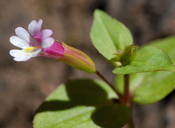Taxon Report
Erythranthe acutidens (Greene) G.L. NesomKings River monkeyflower |
 Barry Breckling |
Taxon Summary
Erythranthe acutidens, commonly known as Kings River monkeyflower, is a annual herb in the Phrymaceae that is found only in California. It occurs within Cismontane woodland, and Lower montane coniferous forest, growing at elevations from 305 to 1220 meters. Erythranthe acutidens is ranked 3, Plants About Which We Need More Information, A Review List.Classification
|
Scientific Name: |
Erythranthe acutidens (Greene) G.L. Nesom |
|
Common Name: |
Kings River monkeyflower |
| Family: | Phrymaceae |
| Element Code: | PDSCR1B010 |
| USDA Plants Symbol: | |
|
Synonyms/Other Names: |
|
Ecology and Life History
| Lifeform: | annual herb |
| Blooming Period: Apr-Jul | Apr-Jul |
| Elevation: | 305-1220 (1000-4005) |
| General Habitats: | Cismontane woodland, Lower montane coniferous forest |
| Microhabitat: | |
| Microhabitat Details: |
Conservation Status
| CA Rare Plant Rank: | 3 |
| Global Rank: | G2G3 |
|
State Rank: |
S2S3 |
| State List: | None |
| Fed List: | None |
| Other Status: | |
|
CRPR Changes: |
|
Occurrence Data from the CNDDB
| Total Occurrences: | 0 |
| Element Occurrence Ranks: | |
| Excellent (A) | 0 |
| Good (B) | 0 |
| Fair (C) | 0 |
| Poor (D) | 0 |
| None (X) | 0 |
| Unknown (U) | 0 |
| California Endemic: True | |
| California Counties and Islands: Name (Code) | |
| Calaveras (CAL), Fresno (FRE), Madera (MAD), Mariposa (MPA), Tulare (TUL) | |
| Quads: Name (Quad Code) | |
| Ahwahnee (3711936), Auberry (3711914), Auckland (3611951), Bass Lake (3711935), Case Mountain (3611847), Columbia (3812014), El Portal (3711967), General Grant Grove (3611868), Giant Forest (3611857), Hume (3611878), Humphreys Station (3611984), Luckett Mtn. (3611972), Mariposa (3711948), Millerton Lake East (3711915), Millerton Lake West (3711916), Miramonte (3611961), Musick Mtn. (3711923), North Fork (3711925), Patterson Mtn. (3611981), Pine Flat Dam (3611973), Sacate Ridge (3611982), Shadequarter Mtn. (3611858), Shaver Lake (3711913), Stumpfield Mtn. (3711947), Trimmer (3611983), Verplank Ridge (3611971), Wahtoke (3611964), White Chief Mtn. (3711945), Wren Peak (3611877) | |
Threat List Data from the CNDDB
| Threat List Total: | 0 | |
| EOs with Threat Listed: | Total EOs | % of EOs |
| 0 | 0 % | |
Notes
| Move to List 4? Location, rarity, and endangerment information needed, especially quads for FRE and TUL counties. Many misidentifications of Sequoia-Kings Canyon NP plants. See Bulletin of the California Academy of Sciences 1:117 (1885) for original description, Phytoneuron 2012-39:1-60 (2012) for revised nomenclature, and Phytoneuron 2012-42:1-4 (2012) for taxonomic treatment. |
|
Threats: |
|
Taxonomy: |
Citation
California Native Plant Society, Rare Plant Program. 2025. Rare Plant Inventory (online edition, v9.5.1). Website https://www.rareplants.cnps.org [accessed 12 December 2025].